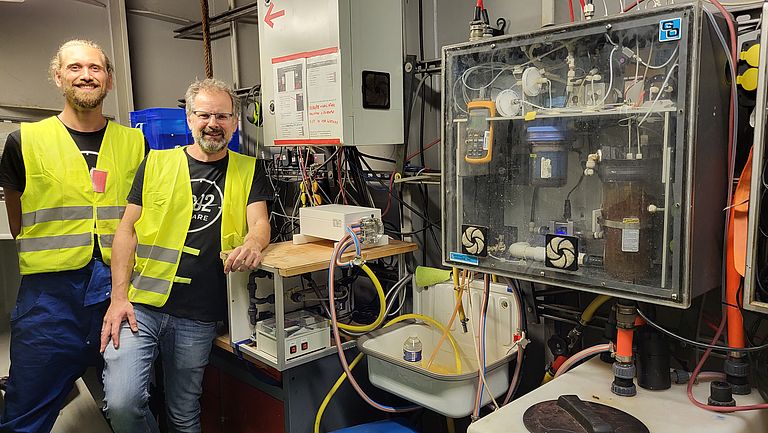Fossil carbon dioxide emissions reach record high in 2023
GEOMAR contributes to Global Carbon Budget 2023 report launched today
The time to achieve the climate targets of the Paris Agreement is running out faster and faster. This is shown by the annual assessment of the Global Carbon Project (GCP). According to the report, fossil carbon dioxide (CO2) emissions are expected to total 36.8 billion tonnes in 2023 and reach a new record level, which is 1.1 percent higher than in 2022. Researchers from GEOMAR Helmholtz Centre for Ocean Research Kiel contribute to this international initiative for several years.
Regional trends were very different: While fossil fuel emissions rose in India and China (+8.2% and +4.0% respectively), they fell in Europe and the United States of America (-7.4% and -3.0% respectively), and slightly in the rest of the world (-0.4%). For Europe, for example, the authors attribute the decline to the expansion of renewable energies and the effects of the energy crisis. The growth in China is partly due to a delayed recovery from the effects of the COVID-related lockdowns.
GEOMAR once again supported this year's report with global measurement data obtained with the help of merchant ships and other platforms. This includes data from the merchant ship MS ATLANTIC SAIL, which was awarded the "Class 1 Label" of the Integrated Carbon Observation System (ICOS) this year, as well as from yachts of the “Ocean Race” regatta.
“Our sustained commitment to observing the marine carbon cycle from various platforms has contributed to this landmark publication for several years,” emphasises Professor Dr. Arne Körtzinger, marine chemist at GEOMAR and co-author of the Global Carbon Budget 2023. “The more we learn about the effects of climate change on the ocean in this way, the clearer the trend becomes. However, one thing has been clear for a very long time: To preserve crucial functions of the ocean, greenhouse gas emissions must be cut down globally.”
Global CO2 emissions far from the required savings
Together with emissions from land use, global CO2 emissions will amount to around 40.9 billion tonnes in 2023. According to the authors, this is far from the significant savings that would be necessary to achieve the Paris climate targets. Although the estimate of the remaining carbon budget is subject to great uncertainty, it is clear that time is running out quickly: If current levels of CO2 emissions continue, the remaining carbon budget for a 50 per cent chance of limiting warming to 1.5 degrees Celsius could be used up in seven years and for 1.7 degrees Celsius in 15 years. “It seems inevitable that we will exceed the 1.5 degree target – and the last few years have drastically shown us how serious the consequences of climate change already are. The heads of state and government at the climate conference in Dubai must decide on significantly greater efforts to reduce emissions in order to at least meet the 2-degree target,” says Professor Dr Julia Pongratz, Professor of Physical Geography and Land Use Systems at Ludwig Maximilian University of Munich (LMU).
CO2 removal reported for the first time
“Although emissions from deforestation have decreased slightly, they are still too high to be offset by renewable forests and reforestation,” says Dr. Clemens Schwingshackl, who, together with Pongratz, led the estimates of land use emissions in the GCP report. Currently, around half of the emissions from deforestation are offset by CO2 uptake in renewable forests and reforestation. Technical solutions such as Direct Air Capture and Carbon Storage (DACCS), which function independently of vegetation, currently only remove a negligible amount of CO2 from the atmosphere. “Massive efforts to reduce emissions are essential for the 'net-zero' emissions targets. To compensate for emissions that are difficult to avoid, a strong expansion of CO2 removal processes will also be necessary,” says Dr Schwingshackl.
El Niño makes itself felt
For 2023, the scientists estimate that around half of the CO2 emitted will be absorbed by sinks on land and in the sea. The rest will be released into the atmosphere, whose CO2 content will rise to an annual average of around 419 parts per million (ppm). The El Niño phenomenon, which began in mid-2023, has probably already had an impact on the land sink: At 10.4 billion tonnes of CO2, the land sink absorbed significantly less CO2 than in previous years, when it absorbed an average of 12.3 billion tonnes. “In El Niño years, the land sink weakens because regions such as the Amazon and Southeast Asia are affected by drought and fires,” says Professor Dr Pongratz. The ocean reacts in the opposite way, even if the variations from year to year are less pronounced than on land. After the exceptional three La Niña years in a row (2020-2022), in which the ocean sink did not increase, CO2 uptake in the ocean is forecast to rise again for the first time in 2023 to 10.6 billion tonnes of CO2.
The scientists assume that the influence of El Niño on the CO2 sinks on land and in the ocean will continue to increase in the coming months and lead to stronger overall growth in atmospheric CO2 levels in 2024.
The Global Carbon Budget Report, produced by an international team of more than 120 scientists, provides an annual, peer-reviewed update that is based on best practices and is fully transparent. It is be presented on 5 December at a press conference at the 28th United Nations Climate Change Conference in Dubai (COP28), where representatives of more than 200 countries meet to discuss the implementation of the Paris Climate Agreement.
Researchers from German-speaking countries from Alfred Wegener Institute, Helmholtz Centre for Polar and Marine Research, Swiss Federal Institute of Technology (Eidgenössische Technische Hochschule, ETH) Zurich, GEOMAR Helmholtz Centre for Ocean Research Kiel, the International Institute for Applied Systems Analysis (IIASA), Karlsruhe Institute of Technology, Leibniz Institute for Baltic Sea Research Warnemünde, Ludwig-Maximilians-Universität München, Max Planck Institute for Meteorology Hamburg, Max Planck Institute for Biogeochemistry Jena, Potsdam Institute for Climate Impact Research and University of Bern.
Original publication:
Friedlingstein et al. (2023) Global Carbon Budget 2023. Earth System Science Data, DOI: https://doi.org/10.5194/essd-15-5301-2023

Sailing Yachts participating in the "Ocean Race" such as the Malizia Seaexplorer collected data on ocean carbon dioxide concentrations. Photo: Marin LeRoux, polaRYSE

Dr. Tobias Steinhoff (right) and Melf Paulsen (left) with their measuring unit onboard the MS ATLANTIC SAIL. Photo: GEOMAR

Title Global Carbon Budget 2023


